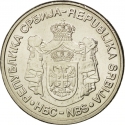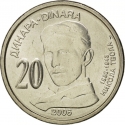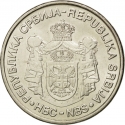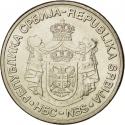You are about to finish your registration. Please check your mailbox (including spam folder). There should be a letter with a confirmation link. Check setting to make sure that your e-mail address is correct.
Send letter againDescription
Ivo Andrić (1892–1975) was a Yugoslav novelist, poet and short story writer who won the Nobel Prize in Literature in 1961. His writings dealt mainly with life in his native Bosnia under Ottoman rule.
He worked in the diplomatic service of the Kingdom of Yugoslavia from 1920 to 1923 and again from 1924 to 1941. In 1939, he became Yugoslavia's ambassador to Germany, but his tenure ended in April 1941 with the German-led invasion of his country. Shortly after the invasion, Andrić returned to German-occupied Belgrade. He lived quietly in a friend's apartment for the duration of World War II, in conditions likened by some biographers to house arrest, and wrote some of his most important works, including Na Drini ćuprija (The Bridge on the Drina).
Following the war, Andrić was named to a number of ceremonial posts in Yugoslavia, which had since come under communist rule. In 1961, the Nobel Committee awarded him the Nobel Prize in Literature, selecting him over writers such as J. R. R. Tolkien, Robert Frost, John Steinbeck and E. M. Forster. The Committee cited "the epic force with which he ... traced themes and depicted human destinies drawn from his country's history". Afterwards, Andrić's works found an international audience and were translated into a number of languages. In subsequent years, he received a number of awards in his native country.
In the years following Andrić's death, the Belgrade apartment where he spent much of World War II was converted into a museum and a nearby street corner was named in his honour. A number of other cities in the former Yugoslavia also have streets bearing his name. In 2012, filmmaker Emir Kusturica began construction of an ethno-town in eastern Bosnia that is named after Andrić.
Obverse

|
Depicts coat of arms of Serbia (with curved bottom of top crown, 2004–2010) surrounded by the country name (above) and an abbreviation of the National Bank of Serbia (NBS) written in Latin and Cyrillic letters. РЕПУБЛИКА СРБИЈА-REPUBLIKA SRBIJA |
|---|---|
Reverse

|
Depicts a portrait of Ivo Andrić, value on the left and above, name, dates of birth and death, on the right, date of issue below. ДИНАРА-DINARA |
| Edge |
5 reeded segments with 19 reeds each |
20 Dinara
2nd Coat of Arms
50th Anniversary of Ivo Andrić’s Nobel Prize
KM# 53
50th Anniversary of Ivo Andrić’s Nobel Prize
Characteristics
| Type | Commemorative Issue (Circulating) |
| Material | Copper Nickel Zinc |
| Weight | 9 g |
| Diameter | 28 mm |
| Thickness | 2.05 mm |
| Shape |
|
| Alignment | Medal |
| Mint |
Institute for Manufacturing Banknotes and Coins (ZIN)
|







